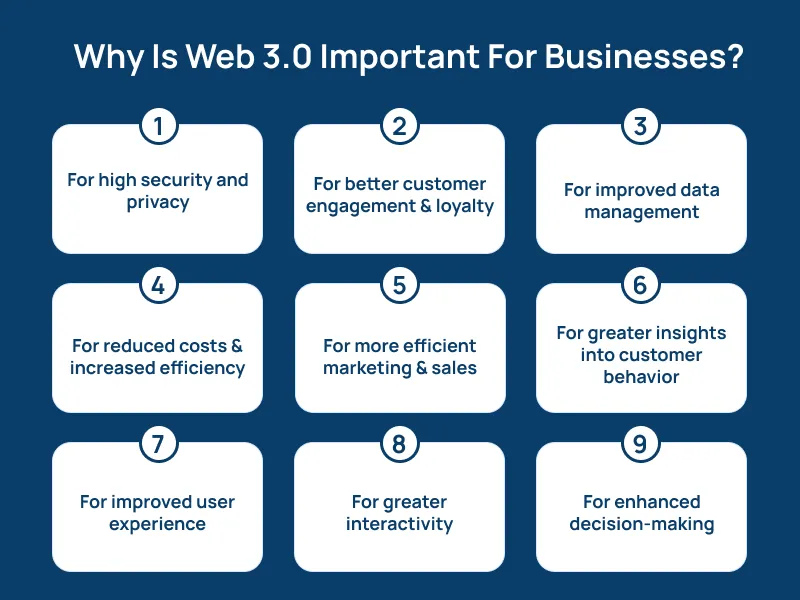With the ever-increasing footprint of technology, it has become necessary for corporations to hold expansive power over digital lives. But, their centralized systems often come with significant flaws that could jeopardize user privacy and security as well as strip users from having any control or ownership.
That’s why the rise of Web 3.0 is quickly changing the landscape of the internet, modern businesses, banking, and finance app development arena. Investors are betting high on the potential of web 3.0 across multiple sectors, including enterprise internet of things and top blockchain development companies.
Get free consultation and let us know your project idea to turn it into an amazing digital product.
Being a new technology, many of us are unaware of what is web 3.0 and how it is becoming important in today’s world.
As Web 3.0 continues to evolve, businesses are recognizing its powerful capabilities for enhancing security, transparency, and productivity. While the potential is great, however, companies must address various challenges before they can truly reap all the benefits that this technology affords them.
Web 3.0 is urging a radical shift in the web landscape, transforming it into an ecosystem that puts users at the wheel and prioritizes decentralization and interoperability – all but essential for businesses to stay ahead of their competition in this day and age.
In this blog, we will seek what is web 3.0 is, its essential components, and why is web 3.0 important for businesses nowadays.
Also Read: A Complete Timeline Guide For Web App Development
A Move From Web 2.0 To Web 3.0
The early years of the World Wide Web were marked by domination from a few large companies including AOL and Microsoft, who controlled the entire content on the web. The users could only access and share certain types of information through them.
Web 2.0 was a groundbreaking development in the online world, with users no longer confined to content created by companies and groups. Now, the users could create their own. This shift from centralized control to distributed power.
Social media platforms (Twitter & Facebook) have revolutionized how we communicate on the internet by moving from centralized control to distributed power.
Here, we are beginning to see a move from Web 2.0 to Web 3.0. We will also seek, “why is web 3.0 important.”
The evolution of the World Wide Web can be divided into three stages:
- Stage 1 – Web 1.0
- Stage 2 – Web 2.0
- Stage 3 – Web 3.0
Web 1.0 – The “Read-Only Web”
- Entered in the 1990s
- Comprised static HTML pages and limited user interaction
- Focused on delivering information to the user, rather than allowing them to actively participate in the web
Web 2.0 – The “Participative Web”
- Emerged in the early 2000s
- Saw a shift towards dynamic, user-generated content and increased collaboration
- Included key features like social networking sites, blogs, wikis, and other user-generated content platforms
Web 3.0 – The “Semantic Web”
- Driving a revolutionary era of connection and intelligence
- Enables access to data always, while building relevant relationships between elements which can be comprehended by humans and machines alike through Internet of Things, Artificial Intelligence, and Machine Learning.
The Web 3.0 age signals a progressive transformation of the web, fostering an environment that serves both people and machines alike.
As businesses step into this revolution, they must now tackle both potential rewards and drawbacks. Utilizing customer data to gain valuable insight into their clientele is now easier than ever, yet proper storage and management of this information can be a costly endeavor without the proper tools.
Also Read: Ruby on Rails vs Java: Which One Is Better For Web App Development?
Definition of Web 3.0
Welcome to ‘Web 3.0’, an intelligent, interconnected web of the future that promises a new level of semantic richness and user-machine interaction!
This next generation blends together current internet capabilities with tomorrow’s technologies like AI, IoT devices, and machine learning for faster navigation through enhanced findability and usability on both ends.
Get ready to experience the best from two digital worlds in one powerful package – Web 3.0!
In Web 3.0, the web is seen as a data network rather than just a collection of documents. This data network is connected by semantic relationships, which allow machines to understand the meaning and context of the data.
Key Features Of Web 3.0
Web 3.0 possesses linked data, decentralized systems, privacy, and security features. These help in creating a more open and transparent web. Here, users will have more control over their data. They can now trust that their information will be secure.
The following are key features of Web 3.0 that businesses should know:
Decentralization: Web 3.0 relies on decentralized systems. There is no single entity present that controls the flow of information or data storage, making it more secure and resilient.
Personal control of data: Users can choose who can access their data and how it will be used. This is a major departure from current web practices, where corporations often monetize user data without permission.
Interoperability: Applications and services can share information across platforms and systems using Web 3.0’s interoperability.
Use of Artificial Intelligence: The use of artificial intelligence in Web 3.0 facilitates complex data analysis and provides intelligent, personalized experiences.
What Are The Challenges Facing In The Adoption Of Web 3.0?
The adoption of Web 3.0 is still in its early stage. In fact, the various challenges need to be addressed before it can become widely accepted.
Lack of awareness: A number of users are unfamiliar with the concept of a decentralized web and how it works. The lack of awareness makes it difficult to get people to use apps built on Web 3.0 platforms.
Technical complexity: Implementing Web 3.0 systems can be complex as it requires significant technical expertise and resources. This can be a barrier for businesses, particularly smaller organizations, to adopt these technologies.
Resistance to change: The shift to Web 3.0 represents a major change for many businesses. There may be resistance to change from stakeholders comfortable with the current systems and processes.
Regulation and legal concerns: The decentralized nature of Web 3.0 raises questions about regulation and legal compliance, and it may take time for governments and industries to establish clear guidelines.
Lack of education and awareness: A large number of businesses might not be familiar with Web 3.0 and its benefits. Hence, it makes it challenging to adopt these technologies.
Scalability Issues: There is no central authority to manage traffic or user data due to its decentralized nature. Hence, it can lead to bottlenecks and slow performance during peak periods. Hence, the scalability issues must be addressed before Web 3.0 can be widely adopted.
Also Read: Top 10 Web App Development Companies To Hire
Overcoming the Challenges
There are many challenges to Web 3.0 adoption, from adapting existing infrastructure to supporting the new technology to getting consumers on board. This is why web 3.0 is important for businesses.
The following strategies can be used to overcome Web 3.0 adoption challenges:
Technical solutions: These technical solutions include cloud-based platforms and managed services. In addition to simplifying the implementation process, these solutions can reduce the technical complexity associated with Web 3.0 adoption.
Education and awareness: By educating businesses about Web 3.0 and showing how it can improve their operations, resistance to change can be overcome. This can be accomplished through industry events, webinars, and other educational materials.
Government and industry collaboration: Governments and industry organizations work together to establish clear guidelines & regulations for Web 3.0 adoption. It addresses legal and compliance concerns. This further helps to create a more favorable environment for businesses to adopt Web 3.0 technologies.
Pilot programs: Many companies launch pilot programs to test Web 3.0 technologies in a controlled environment. This helps in building internal support for the adoption of Web 3.0, as well as demonstrate the potential benefits and overcome technical challenges.
Partnerships: Technology providers and other businesses can help companies adopt Web 3.0 successfully by partnering with them.
Long-term vision: Investing in new technologies and processes is a key component of the adoption of Web 3.0. If your web app development company focuses on the long-term benefits of Web 3.0, you can overcome any initial challenges and prepare for success in the future.
Get free consultation and let us know your project idea to turn it into an amazing digital product.
Why Is Web 3.0 Important For Businesses?
With modern businesses shifting their digital focus, it is vital to stay abreast of technological advancements and maintain a competitive edge.
One such development is Web 3.0. It has generated quite a buzz, set to revolutionize our internet experience.
Here are a few reasons why your business must opt for the web 3.0:
For high security and privacy
The decentralization and personal control of data makes Web 3.0 a more secure and private environment for businesses to operate in. This will help protect sensitive business data as well as customer data from hackers.
For better customer engagement & loyalty
Businesses can increase customer engagement and loyalty by providing a better user experience and respecting user privacy.
For improved data management
With better control over data, businesses can manage their data more efficiently and use it to drive growth and innovation.
For reduced costs & increased efficiency
Businesses can better manage data and use it to drive growth and innovation with better data management.
For more efficient marketing & sales
Businesses can more effectively target their marketing and sales efforts by understanding users’ preferences and interests. This will lead to increased conversion rates.
For greater insights into customer behavior
The ability to gather data from various sources allows businesses to gain valuable insights into customer behavior. It further leads to improved customer service.
For improved user experience
Web 3.0’s increased interactivity provides a better user experience. Websites will be more responsive and easier to use. Moreover, it will make it easier for people to find what they need.
For greater interactivity
HTML5 and JavaScript will make Web 3.0 much more interactive than previous web versions.
For enhanced decision-making
Businesses can make better decisions with real-time data and analytics. They will get know how to allocate resources to maximize efficiency and profits.
Get free consultation and let us know your project idea to turn it into an amazing digital product.
Conclusion
Web 3.0 is a promising new technology that aims to revolutionize how we interact with the internet. Businesses can capitalize on the innovation to grow while enjoying increased security, flexibility, and data privacy.
It won’t be wrong to say that Web 3.0 introduces more democratic aspects to the Internet by curbing the influence of tech giants. Implementing smart contracts and the blockchain can minimize the need for third-party service providers, lessening business costs while bolstering their safety.
As Web 3.0 continues to evolve, businesses embracing this technology will be well-positioned to thrive in the future. But how can you leverage the web 3.0 benefits for your upcoming projects? Hire web app developers from ValueCoders (a leading web app development company in India); we are here to help you 24*7 and bring innovative ideas. Contact us today!










